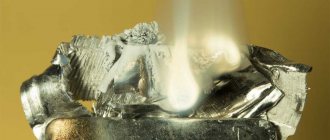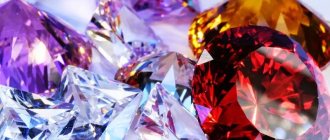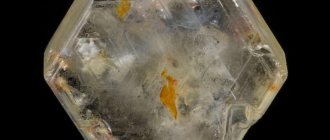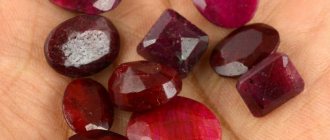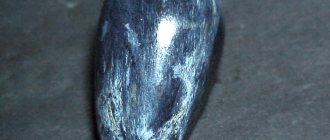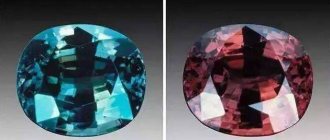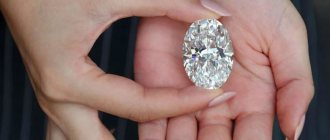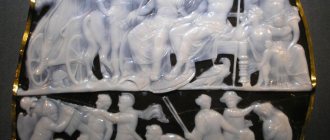Home page Inanimate nature
22 110 2.75 0
At the initial stage of its formation, our planet consisted of rocks, water, fire, and was formed among the roar of volcanoes, flashing lightning and constant collisions of lithospheric plates with each other. The mountains, creeping over each other, destroyed, crumbled and mercilessly maimed each other, as a result of which small and large stones broke off from young rocks and rolled down, destroying everything in their path.
Over time, the planet began to slowly calm down, but the process of crushing rocks has not yet been completed: the earth periodically shakes, crushing rocks and grinding them into small and large stones.
From the author
In this book I want to talk about precious stones - the most beautiful, rare and perfect work of nature. Such a simple formulation, in essence, gives a fairly complete description of these natural formations.
At first, attention to a precious (or otherwise, jewelry) stone was attracted by its beauty - a bright, very clear color or ideal transparency combined with a beautiful color, such as that of “pure water”. The stone is greatly decorated by its “game” - when turning, the stone emits a beam of bright rays. The rarity of such stones is also important. It is the rarity of the stone that gives rise to its high cost. For thousands of years, the gemstone has been a measure of wealth and power. A lot of precious stones are found during archaeological excavations in the graves of pharaohs, Scythian leaders and rulers of the Ancient East. Take a look at the royal clothes in the Armory; they are literally weighed down with precious stones. Of course, such flaunted wealth made a great impression on his contemporaries. It was about the wealth of the Chinese and Indian rulers that Marco Polo and other travelers wrote! of the past. The rich jewelry with stones of Ivan the Terrible was described with surprise by the Englishman Horsey, who came to Moscow to visit the Tsar and left a description of this meeting.
The enormous value of individual gems was the cause of greed and numerous crimes. The history of almost every large stone includes murders, deceptions, thefts, seizures as spoils of war and many other events. But even in modern times, wars sometimes broke out to seize deposits of precious stones. Suffice it to recall the Anglo-Boer War of 1899–1902. in South Africa, which was carried out by England, among other things, with the aim of seizing the largest diamond deposits discovered shortly before.
The rarity and perfection of gemstone crystals are geological issues. A number of minerals, such as, for example, topaz and tourmaline, cannot be called rare; they are found in some places in very large quantities, since they are part of rocks that make up large masses, and in nature these minerals cannot in any way be called precious stones. Ordinary topaz was at one time even used as a raw material for the manufacture of fire-resistant bricks. As a geologist and mineralogist, what attracts me to a gemstone is not its immediate value, but the desire to understand the reasons for the occurrence of those rare, often completely exceptional conditions in which it could be formed. After all, a precious stone must be a perfect crystal, the growth of which nothing has interfered with; as a rule, it should not contain impurities or any inclusions that spoil its appearance and perfection. Or, on the contrary, it must contain “impurities” that give the colorless crystal a bright color or play. This is, for example, the bright green color of emerald. In other cases, it may be a uniform distribution of tiny needle-like inclusions throughout the crystal, giving the stone a peculiar play, as is the case with various “cat’s”, “tiger’s eyes” or star-shaped rubies and sapphires.
This book is written mainly about the problems that arise before a researcher studying a precious stone, and also about those people who are passionate about stones and cannot imagine their lives without searching for a rare and beautiful stone, as well as about the great research work to decipher those mysteries. which the stone places in front of us.
Unlike other minerals, gemstone is more difficult to find than to mine. But it must be obtained in such a way as not to destroy or lose it, but to completely preserve its beauty and size, which is far from easy.
The desire to characterize the most important precious stones as jewelry material of high value, to link these characteristics with the conditions of formation of a given stone and to show the geological and mineralogical conditions in which this or that stone can be found was the main desire of the author and the main difficulty in writing these stories.
Earth's Stone Gifts
Natural stones are hard pieces of rock that appear as a result of crushing. In their structure, texture and composition, they are very different from each other, and therefore there are extremely many types of them: marble, granite, limestone, as well as slates, shell rock, basalt.
Some of them were formed on land, others - under the influence of fresh or sea water. For example, some blocks were formed thanks to mollusks that, dying, sank to the bottom, covering it with shells and shells. Over time, the layer became thicker, denser and after some time collapsed, unable to withstand its own weight, as a result of which shell particles mixed and formed lumps.
Characteristics of precious stones74684.386
Natural stones are the remains of:
- Destroyed sedimentary rocks (75%), which were formed as a result of various erosion processes, primarily weathering and destruction of rocks, mechanical or physical loss of sediment from water, and the vital activity of organisms. Some of the most well-known names for the stones include limestone (a naturally occurring white stone composed of calcium carbonate), sandstone (composed of quartz particles) and marble, a natural stone that was created by the transformation of limestone and dolomite;
- Metamorphic rocks (about 20%) are igneous and sedimentary rocks that were formed inside the planet and changed under the influence of various physical and chemical processes, primarily the pressure of aqueous and gas solutions and high temperature. The most famous natural stone of this type is quartzite, consisting of mica and quartz;
- Igneous rocks that were thrown out by volcanoes from the bowels of the Earth. The most famous type is granite - one of the hardest, most durable and dense rocks. The color of this stone is extremely varied: gray, red, brown, green.
Legends of stones: 5 fabulous stories about precious minerals
The peoples of the world have created many beautiful legends explaining the divine origin of precious stones. We have collected the most interesting and exciting stories.
Share:
Diamond: Eagle Legend
View this diamond ring >>>>>
The most popular gemstone has long been surrounded by many legends. Diamond is often called the "eagle stone". According to one legend, Julius Caesar had a diamond talisman that helped him in battles. And it was found in the liver of an eagle. There are also stories that in the past diamonds were found with the help of these mountain birds. Treasure seekers covered the nest with the eagle chick with glass. Unable to get inside, the bird began to bring diamonds and throw them on the glass to break it. People took the stones collected in the nest for themselves.
Read also: It can’t be - 7 unexpected facts from the world of jewelry >>>>>
By the way, this legend echoes the famous fairy tale about the adventures of Sinbad the Sailor. It also describes an ingenious method of extracting diamonds. The work describes a gorge, the bottom of which was strewn with stones. But access to them was blocked by the many snakes that lived there. To get treasures, people threw pieces of meat into the gorge. The eagles carried them to their nests along with the diamonds stuck to the meat.
Sapphire: celestial legend
View these earrings >>>>> and sapphire ring >>>>>
Since ancient times, sapphires have occupied a special place among precious stones. According to one legend, almighty deities lived on the sacred Mount Kailash in India. One day a man approached them and asked to show them what the coveted “seventh heaven” looked like. In response to the request, the god Brahma sprinkled the drink of immortality amrita around himself. Where the drops fell, blue stones of incredible beauty appeared. These, according to legend, were sapphires.
See also: Which stone will bring you good luck in the new year >>>>>
Surprisingly, to this day the best sapphires in the world are mined on the island of Sri Lanka and in the province of Kashmir, which are located not far from that very mountain. The luxurious color of the stones is still compared to heavenly beauties.
Star sapphires are especially highly valued and are believed to have magical powers and powers. One of these belonged to Helen the Beautiful and, according to legend, was the key to her heavenly attractiveness. As you know, many contenders fought for her heart, which ultimately led to the Trojan War.
Emerald: Greek Legend
View this emerald ring >>>>>
Emerald has always been considered one of the most powerful and mysterious talismans. It has been highly valued since antiquity. The legend of the Samian ruler Polycrates is associated with the emerald. He was successful and extremely lucky. However, his friend, the Egyptian king Masis, warned that all the favorites of fortune would sooner or later face a sad fate. He advised his ally to sacrifice something dear to the gods. Deciding to appease the higher powers with a generous sacrifice, Polycrates threw his favorite ring with a huge emerald into the sea.
See also: Birthstone - determine your main talisman >>>>>
But a few days later the ring was found in a large fish that was caught and wanted to be prepared for the royal dinner. The find discovered in the kitchen was immediately handed over to Polycrates. Then he realized that not a single person can escape the fate destined for him by the gods.
Amethyst: a love legend
View these earrings with amethysts >>>>>
Ancient Greek mythology is rich in legends about stones. There is also a place for amethyst in it. There is a story about a beautiful nymph with violet eyes named Amethys, for whom the god of wine Dionysus had tender feelings. But the girl was in love with someone else - a young shepherd and musician. Having learned about this, the angry god decided to take possession of her power. Then the girl asked for help from her patroness, the goddess of hunting Artemis. To protect Amethys from the persecution of Dionysus, the goddess turned her into a transparent stone statue.
Which stone will bring you luck in love? – take our test and find out >>>>>
Seeing his beloved petrified, the upset Dionysus tried to revive her by pouring wine from a jug. But nothing worked out. Only the wine color gave the stone a unique crimson-lilac hue. Since then, amethyst, named after the nymph, has been considered a stone of fidelity and eternal love. According to legend, Saint Valentine wore an amethyst ring. And in the Middle Ages, girls sewed amethyst into their husbands’ clothes so that their husband would be faithful to them.
Pomegranate: Georgian legend
View this garnet ring >>>>>
There are also legends about its origin, and one of them came to us from Georgia. In ancient times, a local king was looking for a suitable match for his beloved daughter. He decided to test the applicants for his hand and heart and instructed them to find three special pomegranate fruits. They grew on a magic tree in a marvelous garden in a distant desert, which was carefully guarded by evil spirits.
See also: The color of love – who would suit jewelry with pomegranate >>>>>
Only one young man managed to complete the task. The daredevil obtained the magic fruits and brought them to the king. But he found him seriously ill, and the country in terrible famine and drought. The upset hero decided to open magic grenades. When he broke the first fruit, the king immediately recovered and stood on his feet. When the second fruit opened, the gardens blossomed in the country and a rich harvest ripened, saving the people from hunger. And when the young man opened the third pomegranate, precious stones spilled out of it, resembling fruit grains. Since then, it is believed that this stone brings well-being, prosperity and abundance to its owners.
Photo: Shutterstock, 585*GOLD
Valeria Menskaya
Other minerals and rocks
These stones are collectively called minerals. Some of them are minerals, some are rocks, and some were formed from lava foam or plant remains.
Rock salt (mineral halite) . If you clean this mineral from impurities, you get ordinary table salt that we eat. And in nature it is found in the form of huge crystalline blocks. Halite is very brittle and easily dissolves in water.
Feldspar is a mineral that is one of the most common on the earth's surface. The color of the stone ranges from yellowish, greenish to brown.
Quartz is a mineral that forms beautiful oblong crystals. If the crystals are transparent, it is popularly called rock crystal. If they are also colored purple, it is an amethyst. If white - milky quartz. There are many other types of quartz. They are used to make souvenirs and decorations. Quartz is part of granite.
Mica is a layered and shiny mineral. It is part of granite and gives it shine.
Sandstone is a rock consisting of grains of sand cemented by clay or other material. Sandstone can be of different colors, but the predominant color is grey, yellowish-gray or white, and less commonly reddish. It is often used in construction and site design.
Flint . Since ancient times, this mineral has been widely used in flints - devices for making fire. In this regard, one of the elements of flint began to be called flint, although today hardened steel is used instead of the mineral. Flint, moreover, easily splits into sharp fragments, which is why primitive people previously used it to make tools and sharp hunting weapons.
Pumice is fossilized lava, porous volcanic glass formed as a result of the release of gases during the rapid solidification of hot lava. She doesn't drown in water. Pumice is used for hygienic cleaning of heels from dry skin and you can find it in your bathroom.
Granite is a rock that consists of quartz, feldspar and micas. The color of granite depends on the ratio of minerals. Reddish, brownish, greenish or reddish inclusions in granite are pieces of feldspar, dark and shiny are mica, white translucent are quartz. The stone seems to be grainy, and grain in Latin sounds like “granum”, hence the name of the rock - granite. The stone is hard and durable.
Limestone – Chalk – Marble.
The basis of limestone is the remains (shells, shells, skeletons) of mollusks and other ancient inhabitants of the seas. Over the years, they have been crushed and compressed underground. But the rock is still not strong and is washed away by water. Limestone is used as a building stone. Limestone, in which the shells of marine animals and their fragments are visible, is called shell rock.
A special form of limestone is chalk. It is formed by very small organic particles left over from dead marine life. Chalk is fragile and crumbles easily. There are entire chalk islands that seem to have grown out of the sea.
Marble is hardened limestone. It, like limestone, consists of calcite, but also contains impurities. The color of marble depends on these impurities - these are stripes of different shades and curved lines. After polishing, a beautiful pattern appears on the surface of marble, and therefore it is often used for decorative finishing of rooms and buildings.
Peat - Brown coal - Hard coal - Anthracite.
Peat consists of decomposed plants that grow in bogs. Its main component is sphagnum moss. Peat is actively used as fuel, as a fertilizer, and even as a filter for wastewater treatment plants.
Over time, the peat compacts and turns into brown coal.
And if it remains underground for many years, it will become coal. The coal deposits that people mine today were formed from plants that lived on the earth millions of years ago. This is a very long process. Coal is used as fuel.
Over time, hard coal becomes anthracite. On anthracite stones you can sometimes even see imprints of ancient plants - giant ferns. From such plants all the anthracite now existing in the world was obtained.
Iron ore is the main source of iron. It is usually black, slightly shiny, turns red over time, very hard, and attracts metal objects.
If we talk about minerals, we cannot fail to mention oil, although it is not a stone, a mineral, or a rock. Oil is a mineral substance, a viscous dark-colored liquid with the smell of gasoline, flammable. Oil was formed from the decay products of small animal and plant organisms (plankton) that lived millions of years ago. It is mined from the very depths of the Earth. Used to produce fuel, lubricants, and plastics.
Nina ARTYUKHOVAstone
- Oh, are you going to fight?
Vovka bent down and picked up a full handful of small stones.
- It is for you! It is for you!
- They're hitting my earring! Save Seryozhka! - Petya shouted and threw an old mitten, picked up near the fence, at Vovka. The mitten was wet and very dirty.
Seryozha laughed, jumped onto the trash can and stuck his tongue out at Vovka:
- Serves you right, long giraffe!
The girls at school teased Vovka with “giraffe”. But for Sergei, his best friend... Vova’s eyes darkened.
He picked up a stone and a piece of brick from the ground and threw it with all his might at Seryozhka, who was grimacing on the box. He deftly crouched down, the stone whistled over his head and fell in the neighboring yard. A short “ouch!” was heard behind the fence, then a child’s cry and cry was heard: “Mom!”
Sergei looked over the fence and jumped off the box.
- I hit the girl's head. She ran to her mother. Tick, guys!
Sergei and Petya ran away.
Vovka’s first move was to run away. He even took a few steps towards the house, but stopped.
“I hit the girl’s head...” Yes, the stone was heavy and sharp.
Vovka listened. It became very quiet behind the fence. He climbed onto the box and looked at the neighboring yard.
A pile of yellow sand with twigs stuck into it, an abandoned scoop and a bucket... To the side, on a bench near a two-story house, a little girl sat with her head in her hands.
There is a large dark spot on the white cap.
In one leap Vovka jumped over the fence.
- Well, show me what’s wrong with your head!
She looked up at him with tear-stained eyes, took her hands away from her head and sobbed in fear when she saw the blood on her palms.
Vovka carefully raised his hat. There was a large lump on the back of the head, the blond hairs were matted with blood.
Vova’s hands began to tremble.
“So, baby,” he began, trying to control himself, “what’s your name?”
“Natasha,” the girl squeaked.
“Tell you what, Natasha: I’ll take you to your mother.” She will wash your head and tie it up.
“Mom won’t be back until five o’clock, and so will dad,” Natasha said plaintively, “and grandma went to the store.” I ran home, and then I remembered that there was no one at home... and I didn’t run again...
Vovka looked around. There was no one visible in the yard.
- You know? - he said. — My mother is not at home either. Let's go with you straight to the clinic. It's very close. There they will wash you and tie you up... Do you have a scarf?
He took out his own, but immediately put it back.
Natasha handed him a handkerchief, clean and neatly folded. Vovka wiped her face and hands.
- Let's go…
Natasha trustingly placed her little hand in his.
- Maybe it’s difficult for you to walk? Carry you? Aren't you feeling sick? Aren't you feeling dizzy?
Vovka remembered that his mother asked this when he fell from the barn and hurt his head.
- It doesn’t make me sick. I'll go myself.
At the clinic there was a long line in front of the window. Natasha became frightened and squeezed Vovka’s hand.
— Do they make an appointment with a surgeon here? - asked Vovka.
- Here. Get in line, boy.
— I will ask you to register your child out of turn. Accident. The girl's head was pierced.
Those standing in line looked at them and moved aside; the sister handed Vovka a ticket.
They walked along the white corridor and stopped near the surgical room.
“Comrades, this girl is out of turn for a dressing,” Vovka said to those sitting near the door.
- Next! - said the sister.
Vovka nudged Natasha and they entered.
A tall woman in a white robe stood at the sink, washing her hands.
- What do you have, boy? she asked.
“It’s a surgical case,” said Vovka. — The girl was hit in the head by a stone. A lot of blood. She has no one at home, I brought her straight to you.
The sister sat Natasha on a chair and deftly trimmed her hair.
The tall aunt wiped her hands and began to touch her fingers near the bruised area:
- Does it hurt here? Does it hurt here? And so?
Natasha was silent.
- And here, girl, doesn’t it hurt?
Same silence. Vovka saw that the corners of Natasha’s lips were trembling and falling lower and lower.
“She’s in pain,” he said, “only she can bear it.” Are you in pain, Natasha?
“It really hurts,” the girl whispered through clenched teeth.
- Oh, what a heroine you are! - The doctor smiled. “Tell me if it hurts, I don’t want to torture you.”
The sister bandaged it lightly and tightly, it turned out like a white cap or helmet.
— There was no vomiting? Didn't your head feel dizzy? - the doctor asked.
“No,” Vovka answered gravely, “she didn’t feel sick, she didn’t have a concussion.”
The doctor smiled again and began to quickly write something in her large lined notebook.
- Your little sister? she asked.
- Neighbor. There was no one at her house, so I brought her.
“Mom will come at five o’clock,” Natasha whispered barely audibly, “and grandma has gone to the store.”
“So, neighbor,” said the doctor, “take her home and tell her mother to keep her in bed for two days.” After the day off, let them bring you in for a dressing. If you experience nausea or a severe headache, be sure to see a neurologist. Do you know who a neurologist is?
“Of course, I know,” Vovka answered offended. - Which heals nerves.
- Well, goodbye, guys!.. Well done, girl! Hero! And your neighbor is good.
Vovka took Natasha’s hand again:
- Goodbye!
They went out.
When they approached the gates of Natasha’s house, a woman with a frightened face ran out of the gate.
- Mother! - the girl shouted, rushing towards her.
- What do you have? What's wrong with your head? Where have you been?
“A stone hit me from behind the fence, and this boy took me to the doctor.”
Mom grabbed Natasha in her arms. Natasha buried her head in her shoulder and burst into tears, as if she had never been a hero.
Natasha’s dad was running towards them from the other end of the yard, and her grandmother was looking out the window.
- Found! Found!
- Come in, boy! What is your name? Thank you, my dear!.. Come in and tell me what the doctor said.
Natasha was laid on the sofa, Vovka was seated in a chair and questioned vying with each other.
— After the day off, come for a dressing. If you feel nauseous or have a very bad headache, show it to a neuro... nerve... neuropathologist. But this is just in case. But in general, it’s not dangerous. The lump is large and there is an abrasion.
Dad patted Vovka on the shoulder:
- Thank you, thank you, comrade Vova!
- But how did this happen? - asked the grandmother. “We have such a quiet yard, I always leave her calmly.”
“They threw a stone from behind the fence, and this boy saw me.”
“Thank the boy, baby,” Mom said. - Look, what a kind boy!
“Thank you, Vova,” said Natasha.
Vova’s nose tickled.
“Here you are, mom, you attack the kids all the time,” dad turned to grandma, “you say that the kids grow up rude, misbehave, and fight.” Here in front of you is a boy, a schoolboy, a pioneer, who wears a red tie for a reason. I saw a girl in trouble, guessed what needed to be done, and helped her.
Grandma shook her head.
“The hooligan who threw the stone at her probably also had a pioneer tie,” she said. “He ran away calmly and left the poor girl covered in blood.”
- May it be for you! - Mom intervened. - They always argue.
Vovka rose from his chair and began to say goodbye, without looking at anyone. His face was burning. They thanked him. Natasha's dad invited him to come in and promised to show him interesting books.
The girl's eyes sparkled affectionately from under the white bandages.
- Come, Vova!
...Vovka went out into the street. He walked slowly, with his hands in his pockets and his head down. Approaching his gate, he stopped.
No, it’s impossible to leave like that! He turned abruptly and walked again towards Natasha’s house. For a whole minute, maybe more, he stood near the door.
Finally called. Dad opened it for him.
- Vova! Forgot something?
Vovka entered the hallway.
Through the open door of Natasha's room, he saw his grandmother watering flowers by the window. She picked up one pot and looked at it with her glasses on... The round green cactus looked like a small angry hedgehog.
Vovka cleared his throat and spoke in a thin and hoarse voice that was not his own.
“Tell her,” he pointed towards the window, “tell her that I threw a stone over the fence... accidentally hit your Natasha, but didn’t run away anywhere...”
His voice broke.
Vovka rushed to the door, feeling that tears were close. Dad stopped him by the shoulders, turned him to face him and squeezed his hand tightly, like a man.
And the grandmother smiled at her cactus, and even from the hallway it was clear that her face had become completely kind.
